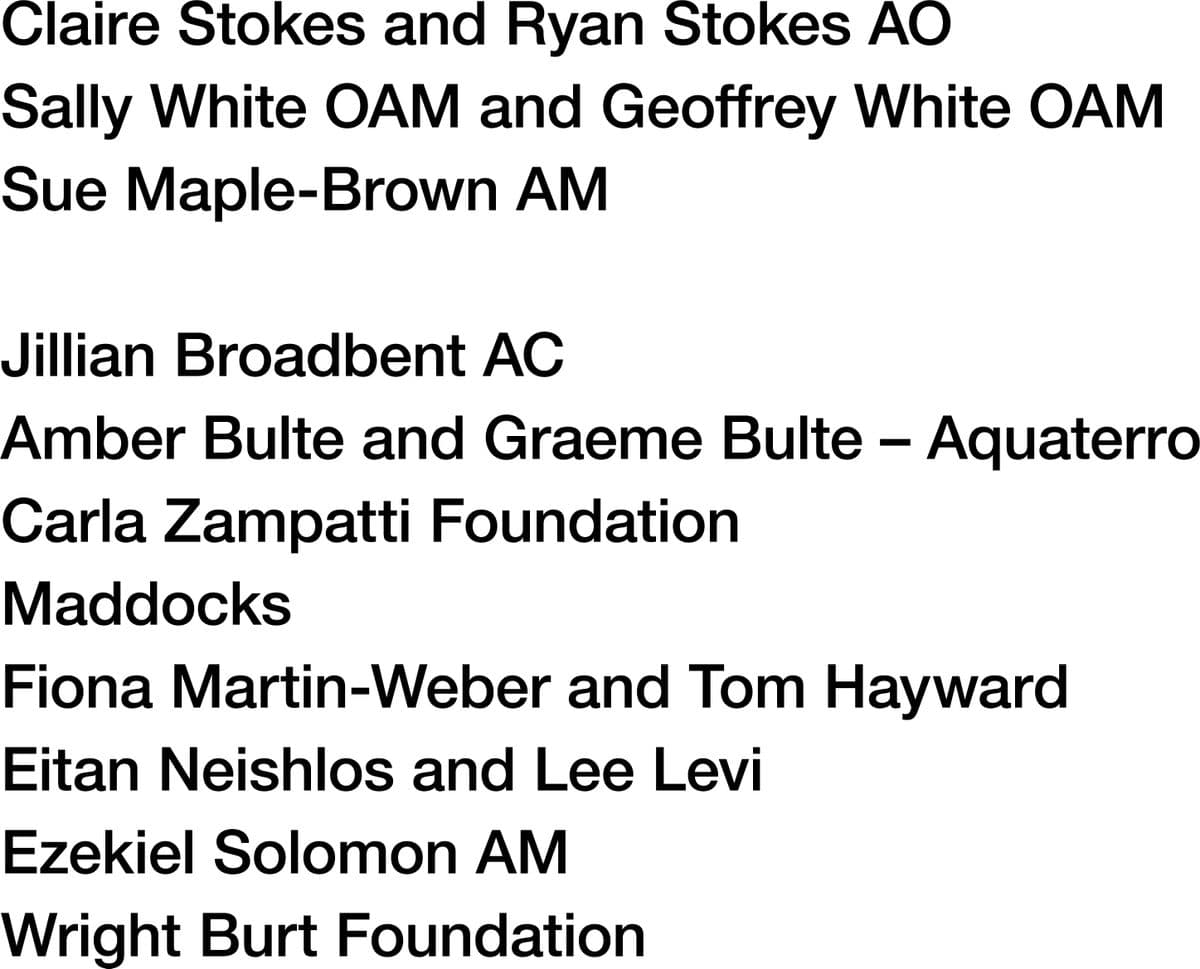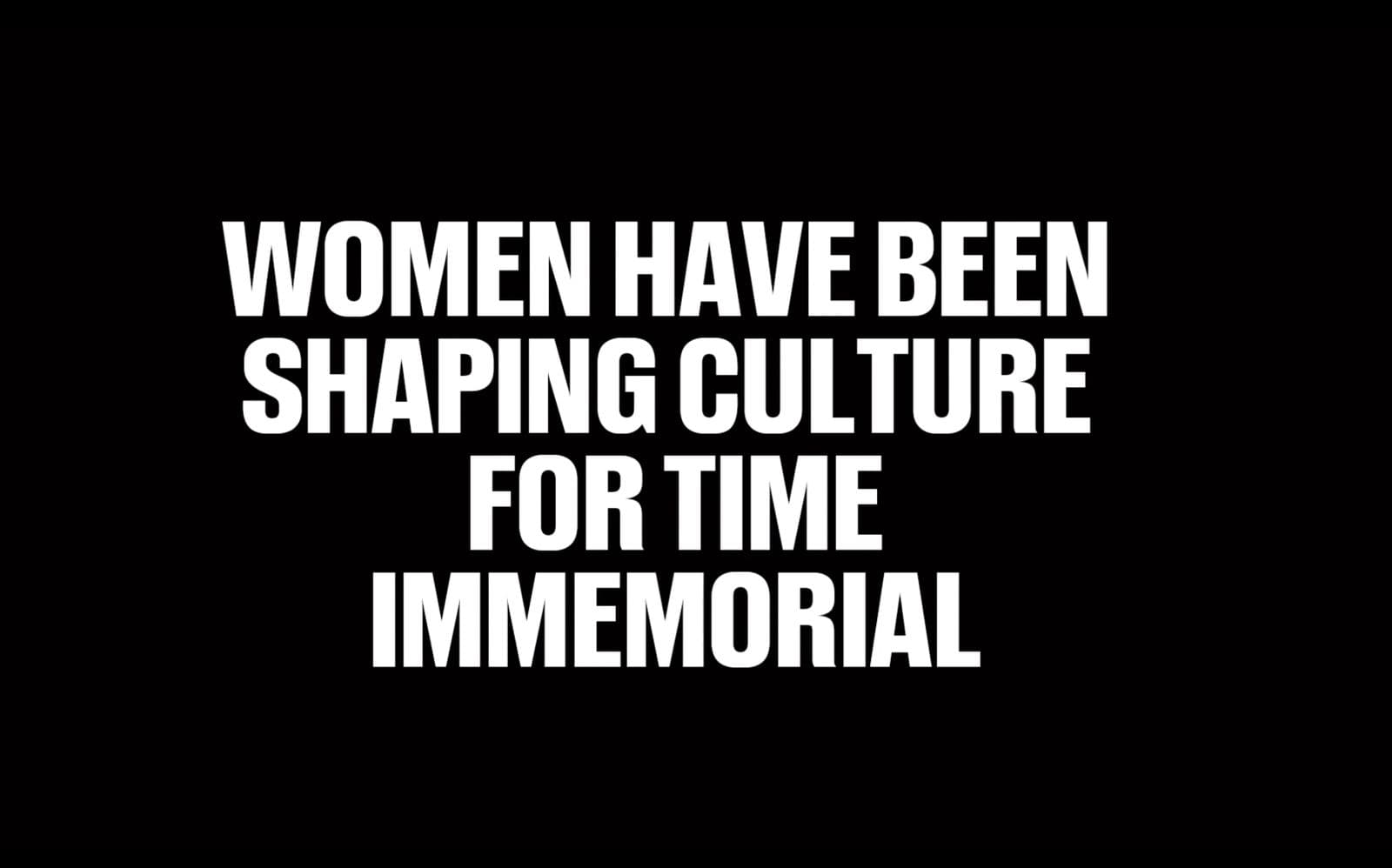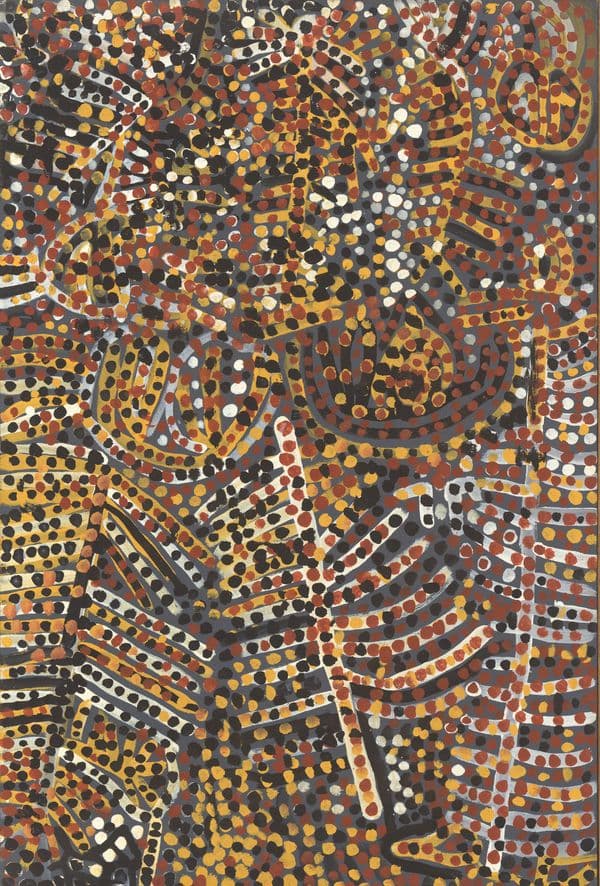Know My Name
Know My Name celebrates the work of all women artists with an aim to enhance understanding of their contribution to Australia’s cultural life.
An initiative of the National Gallery of Australia, Know My Name is a national program of exhibitions, commissions, education programs, partnerships and creative collaborations that celebrates the diversity and creativity of Australian women artists throughout history and to the present day.
In 2019 the Gallery acknowledged that only 25% of its Australian art collection and 33% of its Aboriginal and Torres Strait Islander art collection was by women artists. A commitment was made to change this by establishing the Gallery’s first Guiding Principles for Gender Equity in collection development, programming and organisational structures.
Know My Name is also an invitation to the Australian cultural sector and to communities more broadly, to recognise and highlight the work of women across diverse creative practices.
The Know My Name initiative joins the global movement to increase the representation and visibility of women artists. It builds on the work of groups supporting gender equity across the arts including The Countess Report, Sheila Foundation and the #5WomenArtists campaign by the National Museum of Women in the Arts in Washington, D.C.
Celebrate women artists – see their art, hear their stories, and know their names.
Exhibitions & Projects
-
2 Dec 2023 – 28 Apr 2024
Level 1, Gallery 12
Charges apply
-
Exhibition
SaVĀge K'lub
Upcoming
29 Jun – 7 Oct 2024
Level 2, Gallery 11
Free with ticket
-
5 Aug – 8 Oct 2023
-
27 May – 15 Oct 2023
-
New Collection
Nan Goldin
On Tour
Art Gallery of Ballarat, VIC
2 Mar – 2 Jun 2024
-
Sep 2023 – Sep 2024
Sculpture Garden
Free
-
Horsham Regional Art Gallery, VIC
2 Mar – 19 May 2024
-
14 Nov 2020 – 9 May 2021 (part one)
12 Jun 2021 – 26 Jun 2022 (part two)
Gender Equity Action Plan
On International Women's Day 2022, the National Gallery launched its inaugural Gender Equity Action Plan, the first by a major public visual arts-collecting institution in Australia.
The National Gallery’s commitment to gender equity, demonstrated by the ongoing Know My Name initiative, has influenced the way the Gallery thinks and talks about art and how the core business of building a national collection is approached. Find out more about the Gender Equity Action Plan.
Stories & Ideas
Learning Resources
-
Primary / Secondary
-
Early childhood / Primary / Foundation
On Demand
-
Published 21 December 2022
-
Published 21 December 2022
-
Published 21 December 2022
-
Published 21 December 2022
-
Published 21 December 2022
-
Published 21 December 2022
-
Published 21 December 2022
-
Published 21 December 2022
-
Publication
The Know My Name book celebrates art by women from across Australia. With more than 150 artists profiled and texts written by more than 115 women writers, the book aims to highlight the artists and their work and shift assumptions that the histories of art are male dominated. The book is part of a series of ongoing gender equity initiatives by the National Gallery to increase the representation of all women in its artistic program, collection development and organisational structures.
Edited by Assistant Director, Artistic Programs Natasha Bullock; Curator, Special Projects, Aboriginal and Torres Strait Islander Art, Kelli Cole; Head of Australian Art, Deborah Hart and Curator of Australian Art, Elspeth Pitt. Coordinating Editor, Meredith McKendry and Editorial Assistance, Assistant Curator of Australian Art, Yvette Dal Pozzo. Designed by Fabio Ongarato, John Wilson and Lily Hodgson from Studio Ongarato in collaboration with Kristin Thomas, National Gallery of Australia.
Contents:
Foreword - Natasha Bullock and Nick Mitzevich
Guiding Principles for Gender Equity
Artists (artists and contributors listed below)
Essays:
Know My Name: Australian Women Artists 1900 to Now by Deborah Hart
I Remember, They Remember, We Remember by Elspeth Pitt
Jess Johnson & Simon Ward Discuss Terminus by Jaklyn Babington
The Body Electric: Images of Desire by Anne O'Hehir
Listen to the Music of the Other: Angelica Mesiti ASSEMBLY by Juliana Engberg
Patricia Piccinini Speaks About Skywhales: Every Heart Sings by Jaklyn Babington
From Little Things Big Things Grow: Tjanpi Desert Weavers by Kelli Cole
458 pages
235mm x 305mm
full colour
Hardback RRP:
$79.95 inc GST
ISBN: 9780642334879
Published: 2020
This publication is now available for purchase in store, by phone and online.
Supported by
National Gallery of Australia Foundation Board Publishing Fund
Micky Allan
by Janine Burke
Mirdidingkingathi Juwarnda Sally Gabori
by Tina Baum
Tracey Moffatt
by Natalie King
Jean Baptiste (Pulukatu) Apuatimi
by Margie West
Rosalie Gascoigne
by Deborah Hart
Mirka Mora
by Kendrah Morgan
Yvonne Audette
by Beckett Rozentals
Marea Gazzard
by Rebecca Edwards
Doreen Reid Nakamarra
by Tina Baum
Nyukana Baker
by Mary-Lou Nugent
Simryn Gill
by Naomi Cass
Dorothy Napangardi
by Paris Norton
Del Kathryn Barton
by Julie Ewington
Agnes Goodsir
by Karen Quinlan
Nell
by Beatrice Gralton
Clarice Beckett
by Jennifer Higgie
Agatha Gothe-Snape
by Hannah Mathews
Ann Newmarch
by Julie Robinson
Vivienne Binns
by Virginia Fraser
Julie Gough
by Mary Knights
Rose Nolan
by Sally Foster
Dorrit Black
by Lara Nicholls
Elizabeth Gower
by Anja Loughhead
Susan Norrie
by Kelly Gellatly
Elise Blumann
by Simeran Maxwell
Lola Greeno
by Zoe Rimmer
Lena Nyadbi
by Margie West
Boomalli Aboriginal Artists' Co-operative
by Bronwyn Bancroft
Joan Grounds
by Yvette Dal Pozzo
Mel O'Callaghan
by Elyse Goldfinch
Stella Bowen
by Lola Wilkins
GW Bot
by Yvette Dal Pozzo
Bronwyn Oliver
by Hannah Fink
Joan Brassil
by Susan Best
Fiona Hall
by Julie Ewington
Margaret Olley
by Christine France
Pat Brassington
by Juliana Engberg
Barbara Hanrahan
by Maria Zagala
Raquel Ormella
by Rebecca Coates
Lauren Brincat
by Talia Linz
Gwyn Hanssen Piggott
by Sarina Noordhuis-Fairfax
Jill Orr
by Anne Marsh
Florence Broadhurst
by Anne-Marie Van de Ven
Melinda Harper
by Carolyn Barnes
Ewa Pachucka
by Susan Best
Frances (Budden) Phoenix
by Alison Alder
Claire Healy and Sean Cordeiro
by Beatrice Gralton
Klytie Pate
by Emma Busowsky Cox
Janet Burchill and Jennifer McCamley
by Victoria Perin
Louise Hearman
by Nicola Teffer
Rosslynd Piggott
by Jane Devery
Barbara Campbell
by Jacqueline Millner
Mona Hessing
by Grace Cochrane
Kerrie Poliness
by Carolyn Barnes
Cressida Campbell
by Anne Ryan
Joy Hester
by Denise Mimmocchi
Margaret Preston
by Deborah Edwards
Maria Fernanda Cardoso
by Rachel Kent
Nora Heysen
by Catherine Speck
Thea Proctor
by Lara Nicholls
Ethel Carrick
by Emma Kindred
Margel Hinder
by Denise Mimmocchi
r e a
by Genevieve Greives
Dora Chapman
by Margaret Worth
Joyce Hinterding
by Sarina Noordhuis-Fairfax
Jacky Redgate
by Helen Ennis
Maree Clarke
by Kimberley Moulton
Carol Jerrems
by Anne O'Hehir
Hilda Rix Nicholas
by Anna Gray
Barbara Cleveland
by Bree Richards
Helen Johnson
by Claire G Coleman
Freda Robertshaw
by Sally Quin
Sarah Contos
by Jaklyn Babington
Narelle Jubelin
by Susan Best
Romance Was Born
by Jaklyn Babington
Grace Cossington Smith
by Deborah Hart
Mabel Juli
by Carly Lane
Joan Ross
by Emma Kindred
Olive Cotton
by Helen Ennis
Kitty Kantilla (Kutuwalumi Purawarrumpatu)
by Judith Ryan
Caroline Rothwell
by Anne Loxley
Brenda L. Croft
by Hetti Perkins
Jenny Kee and Linda Jackson
by Rebecca Evans
Julie Rrap
by Victoria Lynn
Grace Crowley
by Elena Taylor
Ken Family Collaborative; Freda Brady, Sandra Ken, Tjungkaraken Ken, Paniny Mick, Maringka Tunkin, Tingila Yaritji Young
by Lisa Slade
Yhonnie Scarce
by Tina Baum
Philippa Cullen
by Diana Baker Smith
Inge King
by Jane Eckett
Sally Smart
by Liz Nowell
Janet Cumbrae Stewart
by Juliette Peers
Emily Kame Kngwarreye
by Kelli Cole
Gemma Smith
by Julie Ewington
Elisabeth Cummings
by Sioux Garside
Yvonne Koolmatrie
by Freja Carmichael
Ethel Spowers
by Cathy Leahy
Virginia Cuppaidge
by Una Rey
Vida Lahey
by Juliette Peers
Robyn Stacey
by Alice Clanachan
Anne Dangar
by Rebecca Edwards
Rosemary Laing
by Victoria Lynn
Miriam Stannage
by Lee Kinsella
Janet Dawson
by Angela Goddard
Pat Larter
by Diana Baker Smith
Madonna Staunton
by Elspeth Pitt
eX de Medici
by Yvette Dal Pozzo
Janet Laurence
by Rachel Kent
Violet Teague
by Jane Clarke
Destiny Deacon & Virginia Fraser
by Magdalene Keaney
Lindy Lee
by Anne O'Hehir
Kathy Temin
by Geraldine Barlow
Karla Dickens
by Tina Baum
Fiona Lowry
by Geraldine Barlow
Thanakupi
by Judith Ryan
Margaret Dodd
by Susan Charlton
Erica McGilchrist
by Linda Short
Esme Timbery
by Genevieve O’Callaghan
Julie Dowling
by Carol Dowling
Queenie McKenzie
by Hannah Presley
Aida Tomescu
by Angela Goddard
Lynda Draper
by Rebecca Edwards
Marie McMahon
by Anna Zagala
Jessie Traill
by Jo Oliver
Mikala Dwyer
by Helen Hughes
Shirley MacNamara
by Katina Davidson
Savanhdary Vongpoothorn
by Bronwyn Campbell
Bonita Ely
by Alex Martinis Roe
Bea Maddock
by Elspeth Pitt
Christian Waller
by Emma Busowsky Cox
Mary Featherston
by Denise Whitehouse
Marion Mahony Griffin
by Marina Warner
Jenny Watson
by Sally Brand
Anne Ferran
by Anne O'Hehir
Hilarie Mais
by Manya Sellers
Judy Watson
by Louise Martin-Chew
Janet Fieldhouse
by Katherine Russell
Noŋgirrŋa Marawili
by Tina Baum
Justene Williams
by Lucina Ward
Emily Floyd
by Anne Loxley
Dr B. Marika
by Ellen van Neerven
Margaret Worth
by Mary Eagle
Fiona Foley
by Marina Tyquiengco
Linda Marrinon
by Charlotte Day
Judith Wright
by Geraldine Barlow
Sue Ford
by Maggie Finch
Helen Maudsley
by Pip Wallis
Lena Yarinkura
by Michelle Culpitt and Lena Yarinkura
Mari Funaki
by Jane Devery
Sanné Mestrom
by Lisa Slade
Nyapanyapa Yunupiŋgu
by Tina Baum
Partners & Donors
To find out about Know My Name partnership opportunities contact the National Gallery's Partnerships team.
Principal Patron
-
Tim Fairfax AC

Strategic Partners
-
Visit Canberra ACT Government
Visit the website for Visit Canberra ACT Government

-
Channel 7
Visit the website for Channel 7

-
ooh Media
Visit the website for ooh Media

Major patrons

Exhibition Patrons
-
Naomi Milgrom Foundation
Visit the website for Naomi Milgrom Foundation

-
Neilson Foundation

-
Medich Foundation
Visit the website for Medich Foundation

-
The Balnaves Foundation
Visit the website for The Balnaves Foundation

-
The Keir Foundation
Visit the website for The Keir Foundation

-
National Gallery Foundation

Major Partners
Supporting Partners
-
Doma Hotels
Visit the website for Doma Hotels

-
Archie Rose Distilling Co
Visit the website for Archie Rose Distilling Co

-
Veuve Clicquot
Visit the website for Veuve Clicquot

Publication Partner
-
NGA Foundation Board Publishing Fund

Cultural Partners
-
Australia Council for the Arts
Visit the website for Australia Council for the Arts

-
ABC
Visit the website for ABC

-
Countess Report
Visit the website for Countess Report

-
Wikimedia Australia
Visit the website for Wikimedia Australia

-
National Museum of Women in the Arts
Visit the website for National Museum of Women in the Arts

-
Kambri at ANU
Visit the website for Kambri at ANU

-
Sheila Foundation
Visit the website for Sheila Foundation

-
Vogue Australia
Visit the website for Vogue Australia

Education Partners
-
Australian National University (ANU)
Visit the website for Australian National University (ANU)

-
University of NSW
Visit the website for University of NSW

-
University of Melbourne
Visit the website for University of Melbourne

Media Partners
-
The Sydney Morning Herald
Visit the website for The Sydney Morning Herald

-
The Age
Visit the website for The Age

-
The Design Files
Visit the website for The Design Files

Promotional and Retail Partners
-
Audi Centre Canberra
Visit the website for Audi Centre Canberra

-
Flash Graphics
Visit the website for Flash Graphics

-
Capital Brewing Co
Visit the website for Capital Brewing Co

-
Mud Australia
Visit the website for Mud Australia

-
Bonnie and Neil
Visit the website for Bonnie and Neil

Supporting Patrons
American Friends of the National Gallery of Australia with the generous support of Geoffrey Pack and Leigh Pack
Antionette Albert
Sue Cato
Penny Clive AO
Helen Cook
Martin Dickson AM and Susie Dickson
Gandel Philanthropy
Kerry Gardner AM
Pauline Harding
Colin Hindmarsh and Barbara Hindmarsh
Phillip Keir and Sarah Benjamin
Alana Kirby
Dr Andrew Lu OAM and Dr Geoffrey Lancaster AM
Elizabeth Pakchung
Suzannah Plowman
Tom Pongrass
Penelope Seidler AM
The Sun Foundation
Rhonda White AO
Ray Wilson OAM
Contributors
Lenore Adamson
Philip Bacon AM
Kay Bryan
Sue Dyer and Steve Dyer
Emeritus Professor Barbara van Ernst AM
Sarah Greer and Damian Clothier QC
Judy Gray and Rod Pilbeam
Wayne Kratzmann
Josh Milani and Danielle Milani
Jan Murphy and Sydney Williams QC
Gary Sands
Dr Sally Sojan
John Story AO and Georgina Story
Wendy Webb
Supporters of the 2020 Gala Fund
The Hon Richard Alston AO
The Aranday Foundation
Philip Bacon AM
Julian Beaumont OAM and Annie Beaumont
Berg Family Foundation
Tony Berg AM and Carol Berg
Kay Bryan
Andrew Buchanan PSM and Kate Buchanan
Robyn Burke and Graham Burke AO
Burton Taylor Foundation
Robert Cadona
Andrew Cameron AM and Cathy Cameron
Terry Campbell AO and Christine Campbell
Maurice Cashmere
Sue Cato
Dr Andrew Clouston
Marilyn Darling AC
The Hon Ashley Dawson‑Damer AM
Tim Fairfax AC and Gina Fairfax
Michael Gannon and Helen Gannon
Julian Goldenberg and Neta Saint
Richard Griffin AM and Jay Griffin
Bill Hayward and Alison Hayward
Sue Hewitt
Sam Hill-Smith
Meredith Hinchliffe
John Hindmarsh AM and Rosanna Hindmarsh OAM
Neil Hobbs and Karina Harris
Jo Horgan and Peter Wetenhall
Mark Hughes
Wayne Kratzmann
Paul Lindwall and Dr Joanne Frederiksen
Dr Andrew Lu OAM and Dr Geoffrey Lancaster AM
Sue Maple-Brown AM
Suzanne Maple-Brown and Anthony Maple-Brown
Dr Michael Martin and Elizabeth Popovski
Fiona Martin-Weber and Tom Hayward
Robert Meller
Naomi Milgrom AO
Jan Minchin
Baillieu Myer AC and Sarah Myer
Rupert Myer AO and Annabel Myer
Roslyn Packer AC
Elizabeth Pakchung
Kenneth Reed AM
Gary Sands and Garth Richardson
Diane Smith-Gander AO
Jane Smyth OAM and Dr Rick Smyth
Ezekiel Solomon AM
Sullivan Strumpf Fine Art
Urban Art Projects
Sally White OAM and Geoffrey White OAM
Ray Wilson OAM























//national-gallery-of-australia/media/dd/images/354643_-_Large_Viewing_JPEG_4200px_1.jpg)





//national-gallery-of-australia/media/dd/images/78637_apm_-_Overview_-_Large_Viewing_JPEG_4200px.jpg)














































